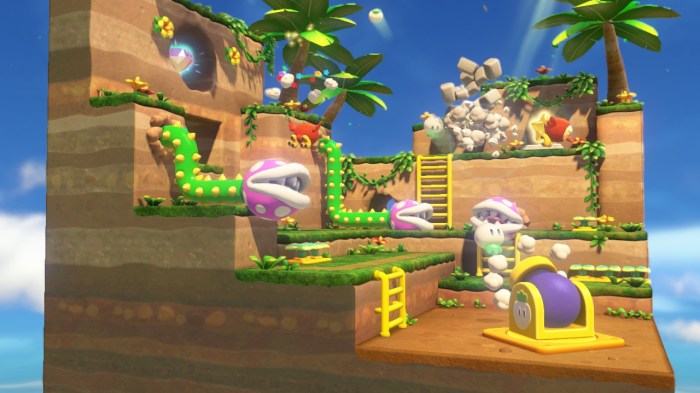Captain Toad: Treasure Tracker is the first game to implement Nintendo‘s strategy of recycling assets to quickly create high quality games with a smaller team and budget. Actually, that’s a bit of a fib. Nintendo has used this strategy before, or something very similar, with a little game called The Legend of Zelda: Majora’s Mask. Not a bad proof of concept if you ask me, so we already know their new reliance on reusing assets can produce gold. Captain Toad‘s minigames were a big hit with many who played Super Mario 3D World, but can you really build a retail title around them?

Captain Toad: Treasure Tracker borrows the majority of its graphical assets from Super Mario 3D World, a game that is arguably one of the best looking Nintendo title on the market today. They’ve been polished up a bit since the stages tend to be smaller, diorama styled levels focused on exploration. There are a handful of new enemy models that also capture the feel that permeates everything Nintendo does. Visually, Captain Toad is one of the best on the Wii U.
Captain Toad‘s first game is similar to its aesthetics in practice: Simple, but well made. It has changed quite a bit from the Super Mario 3D World minigames players fell in love with, but in a good way. The stages can become far more elaborate and offer many new ways to interact. Captain Toad still can’t jump, so players have to make up for this deficit with their cunning and mastery of the tools at hand. Our plucky protagonist can pluck vegetables for makeshift projectiles, run as fast as his stumpy legs and weighty backpack will allow, subdue photosensitive enemies with his headlamp, manipulate stages and enemies through touch controls and take advantage of other mechanics that vary by stage. The game builds on everything introduced at each successive encounter, with a very reasonable learning curve. The special objectives can require players to take things they’ve learned from previous encounters and apply them in new situations.

The majority of the game play revolves around how players look at things, literally and figuratively. Manipulating the camera allows players to see new paths and options that were intentionally obscured before. In a typical Mario game a few Goombas, a Chargin’ Chuck or a small drop off would be a trivial issue. With Captain Toad‘s vertical impairment, players have to form a plan and execute it to meet objectives. In this way, Captain Toad‘s difficulty and game play approach scales with how goal-oriented the player is while playing. Special objectives can add a level of difficulty, depth and replay value to the game for those interested.
For example, a Chargin’ Chuck is shown to barrel through anything in its path, be it the Captain, a rock block or another foe. Later, players will encounter Mud Troopers, where the inquisitive will learn that they can be scared into retreating into the ground by prolonged exposure to the headlamp. This doesn’t defeat them, it simply gives the Captain a little respite until they reemerge. Later still, players will be given a special objective to defeat all mud troopers, but aren’t given the means to do it directly. The Captain is only given a handful of vegetables to take on a veritable horde of Mud Troopers, so how can this be done? With a little thinking outside of the box, Captain Toad can recruit a Chargin’ Chuck from halfway across the level to solve this problem.

There are also stages that break the mold. Pipes and turrets offer interesting respites from the usual, but the show stealer is the mine cart. Some levels will take place almost entirely on rail and the player has to use the first person perspective offered on the game pad to throw vegetables at enemies and objects in the environment. It’s a great diversion and really reminds me of another Nintendo property that needs to be done on the Wii U: Pokemon Snap.

Finally, there’s just so much attention to detail and hidden Easter eggs jammed into this little package. Players can find tiny wanted posters of Wingo posted throughout stages, and touching them tears them off the wall while rewarding players with a coin. Stages with snow allow players to write in it on the touch screen. The headlamp can alert enemies to your presence and may need to be turned off for stages with stealth objectives. The Captain and Toadette will become dizzy if players spin them in circles too fast. There are 8-bit Luigis hidden throughout the game, Wingo’s Turban has a familiar magic feather stuck into it, there’s at least one Donkey Kong inspired stage and much more. I’ve played quite a bit and I feel I still haven’t seen every Easter egg or bit of trivia crammed into the game.
Captain Toad: Treasure Tracker is a great game, but still not perfect. The flaws are few and far between, but they do exist. They aren’t game breaking or even terribly annoying for the most part, and they really seem like simple oversights. The game pad functionality is great. I love almost everything about it, but it still suffers from poor resolution. Having to look away from the beautiful graphics on screen to the noticeably lesser graphics on the game pad is a bummer for mine cart sections and push block levels. However, the biggest complaint about Captain Toad is the camera. It’s fine and functional, but Nintendo failed to give the option to turn gyroscopic camera control off, which hinders game play for those that don’t keep the game pad planted on a surface while using touch controls. This could be patched in later, but it’s still baffling that they didn’t have the option to turn it off from the start.













